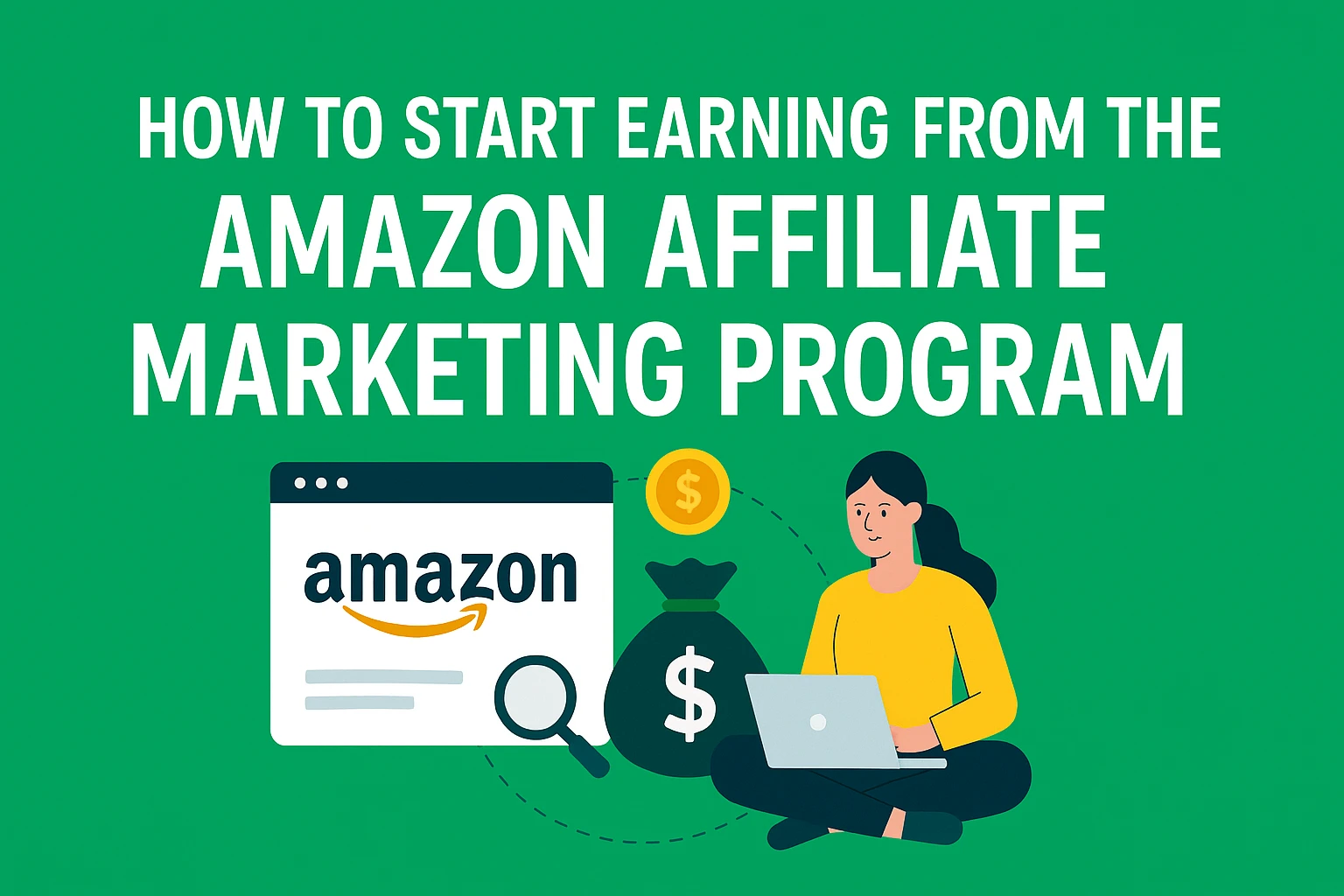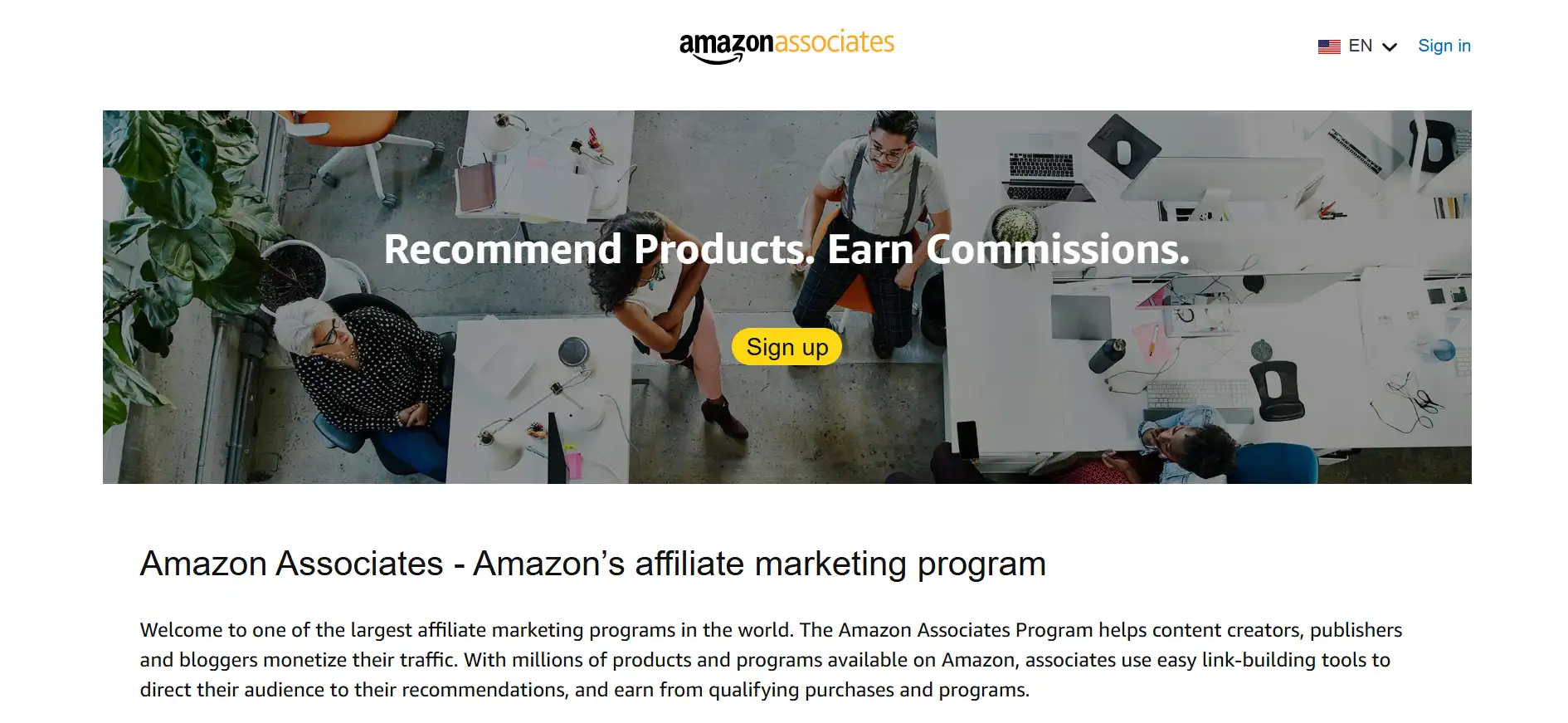How to Start Earning from the Amazon Affiliate Marketing Program Without a Website or Huge Following
Learn how to earn from the Amazon affiliate marketing program without a website or followers. Discover smart, beginner-friendly strategies that actually work.

You don’t need a blog or 10,000 followers to earn from the Amazon affiliate marketing program.
That might go against what most people are saying online, but I’ve seen it firsthand. People with no audience, no website, and zero online presence making their first affiliate commissions using simple tools and free platforms. Not overnight money, but real earnings that grow with consistency.
Here’s the truth. You don’t have to be an influencer. You don’t need to write blog posts every day. You don’t even need to show your face. What you do need is a clear strategy, a basic understanding of how affiliate links work, and the right places to put those links.
Most beginners overthink this. They waste time building websites they don’t finish or chasing shiny tools that don’t actually help them get clicks. Others sign up for the Amazon affiliate marketing program and then get stuck, staring at the dashboard with no idea how to start. Sound familiar?
This guide is for you if:
- You want to start earning with Amazon without building a blog or buying ads
- You have little to no social media following
- You want straight answers, not recycled tips or theory
I’ll walk you through real methods that work even if you’re starting from scratch. These are things I’ve used myself and taught others to use too. You’ll learn where to share your links, how to stay compliant, and how to make the most of Amazon’s short cookie window.
Let’s get to it.
📌Key Takeaways
- You can start earning from the Amazon affiliate marketing program using free platforms—no site, no list, no excuses.
- Pinterest is a goldmine for beginners. Search-based pins with clean design and solid keywords can bring traffic without followers.
- Quora and Reddit work if you give real answers first, and drop links second. People sniff out spam fast.
- Use Amazon’s native shopping ads or SiteStripe links, don’t try to cloak or disguise your affiliate links.
- Short-form videos (like YouTube Shorts or Reels) work even with zero subs. Focus on trending products or simple how-to demos.
- You don’t need to review every product you promote. Curated lists or comparisons work just as well.
- Don’t promote low-ticket items unless they’re part of a bigger shopping journey. Look for products that lead to higher cart value.
- Expect small earnings at first. Use that time to master click behavior, copy, and platform dynamics—this is the real skillset.
What Is the Amazon Affiliate Marketing Program
The Amazon affiliate marketing program, officially called Amazon Associates, is Amazon’s way of letting everyday people earn money by recommending products.

Here’s how it works. Once you sign up, Amazon gives you a unique tracking link for any product you want to promote. When someone clicks that link and buys something on Amazon, you earn a small percentage of the sale. That percentage depends on the product category, but it usually ranges between one and ten percent.
You don’t need to handle inventory or customer support. Amazon takes care of all of that. Your job is simply to help shoppers discover products they might want and send them to Amazon using your link.
Now here’s why this program works so well. People already trust Amazon. They use it daily to buy everything from phone chargers to home gym equipment. That trust makes it easier for your link to convert into sales, even if you’re just starting out.
Another benefit is the range of products. Amazon sells just about everything, which means you are not boxed into a single niche. Whether you want to talk about books, beauty products, kitchen tools, or pet supplies, there is something you can promote that fits.
And here’s a bonus most beginners miss: even if someone clicks your link and buys something completely different from what you recommended, you still get the commission. That’s because your link tracks all qualifying purchases during that visit. One click can lead to multiple commissions.
In short, the Amazon affiliate marketing program turns your content—no matter how simple—into a way to earn real money. You send the traffic. Amazon handles the rest.
Why You Don’t Need a Website or Big Audience
One of the biggest myths in affiliate marketing is that you need a full website or thousands of followers to make money. That’s just not true. I’ve made commissions without either. So have plenty of others.
The truth is, platforms today give you other ways to share your affiliate links. Places like Pinterest, Quora, Reddit, Medium, TikTok, and YouTube Shorts let you reach people without needing a blog or a big personal brand. Each has its own limits and rules, but if you follow them and focus on value, they work.
On Pinterest, you can create product pins that show up in search. Quora and Reddit let you answer questions or join conversations—if you’re helpful first, your links are welcome.
Medium lets you write product roundups or tutorials. TikTok and YouTube Shorts are great for short demos or “best under $50” style videos. These platforms already have the traffic. You just need to show up and offer something useful.
This approach also keeps costs low. You’re not buying hosting, themes, or worrying about SEO. You can test fast and learn what works without sinking time into building a full website.
Personally, I started this way too. I tested links on Pinterest and answered questions on Quora long before I ever built my first blog. I was able to see what converted and what didn’t. That made it easier when I eventually launched my site because I knew what products and angles worked.
If you’re still unsure, check out my full breakdown here: [Do You Need a Website to Start Affiliate Marketing? Here is My Take]. I explain why skipping the website route—at least in the beginning—can actually be a smart move.
So no, you don’t need a website. You need a clear plan, the right platforms, and a bit of consistency. That’s it.
6 Smart Ways to Promote Amazon Affiliate Links Without a Website
You don’t need a site to start earning. These six methods let you share affiliate links directly, even if you’re just starting from scratch. I’ve used most of them myself or seen others get results with them.
1. Pinterest Pin Funnels
Pinterest acts like a search engine, not a social network. People go there to find ideas, not just scroll.
Use Canva to design simple vertical pins that link straight to Amazon products. Think “best desk lamps for small spaces” or “kitchen tools under 25 dollars.” Focus on keywords people actually search for.
You can link the pin directly to the Amazon product or to a bridge page if you want to warm up the traffic. Keep it clean and don’t overdo it with text.
Pro Tip: For Pinterest Pin Funnels to actually work, post 5 to 15 pins a day. The algorithm favors fresh, consistent content. Mix up keywords, try different angles, and keep the momentum going. I recommend using BlogToPin to schedule and automate—it saves time and keeps your posting steady without burning out.
2. Quora Answers That Rank
Quora answers show up on Google. That’s free search traffic with long shelf life.
Search for questions like “What’s the best mouse for working from home” or “What should I buy for a small kitchen.” Write helpful, honest answers. Then link to the product on Amazon using your affiliate link.
Don’t drop links right away. Build trust with your answer. People click more when the advice feels real.
3. Reddit Product Recommendations
Reddit is strict, but golden if you know how to blend in.
Look for threads where people ask for advice—like “best travel backpack” or “gadgets for small apartments.” Offer a real answer. If the subreddit allows it, drop your affiliate link. Some allow direct links. Others only allow them in comments or not at all.
Always read the rules first. And never make it about selling. Just be helpful.
Read Also: How I Made My First $500 Using Reddit for Affiliate Marketing (Without Spamming)
4. YouTube Shorts
YouTube Shorts are blowing up right now. You don’t need a studio or fancy gear. Your phone is enough.

Make short videos showing or talking about the product. Think “3 tools every home office needs” or “this thing changed how I store spices.”
Add your affiliate link in the description. You can use a redirect tool or a simple landing page if needed. Just be clear in the video that the link is in the description.
5. Medium Product Reviews
Medium gives you a free place to write, and posts can rank on Google.
Pick a product you’ve used—or one you’ve researched well—and write a quick review. Compare two similar items. Do a roundup. Add your Amazon link where allowed.
Make it useful. Talk about who the product is for, pros and cons, and what to expect. Keep it honest.
6. Email Newsletters
Start a simple weekly email list. You don’t need a massive list—just a focused one.
Use free tools like GetResponse or ConvertKit. Offer a lead magnet like “10 Must-Have Kitchen Finds Under 20 Dollars” to get people to sign up.
Each week, send product tips or roundups with affiliate links. This works great if you stick to one niche and keep the emails short and helpful.
These methods don’t need big tools, and they let you test fast. The trick is to be consistent and always focus on what helps the reader. That’s what gets clicks—and commissions.
Recommended Reading: 12 Best Free Email Marketing Tools You Need For Your Affiliate Business
How to Stay Compliant with Amazon’s Rules
Amazon runs a tight ship. If you break the rules, even by accident, they can shut down your account and withhold your commissions. So before you start posting links everywhere, get the basics right.
Here are the big things you need to avoid:
1. No cloaked or shortened links: Amazon wants full transparency. You can’t use link shorteners like Bitly or tools that mask your affiliate link. The raw Amazon Associates link is what you should share. If you want to clean things up, use a proper redirect on your website (if you have one), but not for email or social media unless the platform clearly allows it.

2. No affiliate links in emails or offline PDFs: You’re not allowed to include Amazon affiliate links in emails, ebooks, PDFs, or any downloadable file. That includes newsletters, lead magnets, and private PDFs. If you’re using email, link to a blog post, landing page, or video that contains the affiliate link—not the affiliate link directly.
3. Always include a disclosure
This is non-negotiable. You need to tell people that you’re using affiliate links. It’s both an Amazon rule and an FTC requirement. The disclosure needs to be clear and upfront—don’t bury it in a footer.
Example of a simple disclosure:
“This post contains affiliate links. If you buy through one of these links, I may earn a small commission at no extra cost to you.”

That’s enough to keep things honest and protect yourself.
For the full rules, always check the official Amazon Associates Program Operating Agreement. They update it often, so it’s smart to bookmark it.
The bottom line: treat affiliate links like a business, not a shortcut. Staying compliant builds trust and keeps your account safe. And if you’re playing the long game, that’s what really matters.
Tools to Make It Easier (Even If You’re Just Starting Out)
You don’t need a full tech stack to get started with the Amazon affiliate marketing program—but a few smart tools can save you time and keep you organized. These are the ones I’ve used or recommend for beginners who want to stay efficient without overcomplicating things.
1. Canva – for visuals that get clicks: Whether you’re making Pinterest pins, YouTube thumbnails, or Medium post headers, Canva makes it easy. Use their free templates, drag in your product images, and boom—you’ve got a pro-looking graphic in minutes.
2. ClickMeter – for link tracking: If you don’t have a website, ClickMeter is a solid tool. It helps you track your Amazon affiliate links across platforms like Pinterest, Quora, or YouTube. You’ll see where clicks are coming from, which links perform best, and what’s worth doubling down on. No website needed, and the setup is simple.
For a full list of tools, check out this post: [Top 14 Free Link Tracking and Management Tools for Affiliate Marketers].
3. BlogToPin – Pinterest automation tool: If you’re posting affiliate content on Pinterest, scheduling pins consistently is key. BlogToPin helps you automate that part. Set up a week’s worth of pins, and let it run while you focus on creating content or researching products.
4. Ubersuggest – for basic keyword research: Before I create any piece of content or Pinterest pin, I like to know what people are searching for. Ubersuggest helps you find keywords with decent search volume and low competition. It’s not the only tool, but it’s one of the easiest to start with.
5. GetResponse – for simple email marketing: Even if you don’t plan to run a full newsletter right away, you’ll want a way to collect emails down the line. GetResponse makes that easy. You can set up a lead magnet, landing page, and simple autoresponder—all without coding.
6. SocialPilot – to schedule social media posts: If you’re testing across platforms—like Pinterest, TikTok, or even LinkedIn—SocialPilot helps you line everything up in advance. I use it to batch and schedule content across channels so I don’t lose momentum.
You don’t need all these tools on day one. Start with what fits your strategy. As you grow, add more. Keep it simple, track what’s working, and double down on the platforms that drive clicks.
Realistic Expectations and Smart Tips
Honestly, you’re not going to hit $500 a day next week. And anyone who tells you otherwise is probably selling hype. But that doesn’t mean this can’t work. It does—but only if you treat it like a skill, not a lucky break.
Here’s what I tell anyone starting out with the Amazon affiliate marketing program:
1. Focus on clicks first
You can’t make sales if no one’s clicking your links. Your first goal should be traffic—real people seeing your content and clicking through. Don’t worry about the conversion rate in week one. Just get the engine moving.
2. Stick to 1 or 2 methods
Don’t spread yourself too thin. I’ve seen beginners try Pinterest, Quora, Reddit, Medium, and email—all at once. It never ends well. Pick one platform that fits your style. Maybe Pinterest if you like visuals. Maybe Quora if you like writing short answers. Get good at that, then layer on another.
3. Track what works and adjust
Even with the same product, results can vary a lot depending on where you promote it. Use tools like Google Sheets or ClickMeter to track clicks, posts, and platforms. If something’s not working, change it. Don’t waste weeks pushing a method that’s clearly not getting results.
4. Be patient, but be consistent
This is slow at first. But if you post three good answers a day on Quora or five quality pins a week, things stack up. I’ve had affiliate links that did nothing for a month suddenly bring in daily clicks from an old post that finally ranked.
5. Study your content like it’s a product
What got clicks? What didn’t? Why did that pin take off but the other one flopped? Ask those questions. The people who win at affiliate marketing are the ones who treat it like a real craft. They study, improve, and test like they’re building something serious—because they are.
Success in affiliate marketing without a website or big audience is possible. But only if you take it seriously, stay consistent, and focus on learning. If you do that, the results will show up. Not overnight—but they’ll come.
Conclusion
You don’t need a fancy blog or thousands of followers to start earning from the Amazon affiliate marketing program. What you do need is consistency, the right platforms, and a basic understanding of how to stay compliant.
I’ve seen beginners get their first commissions just by answering product questions on Quora or posting simple pins on Pinterest.
Start small. Pick one or two methods. Track what works. And remember, this isn’t a get-rich-quick thing—it’s a skill. The more you practice, the better your results.
If you’re still unsure where to begin, go back to Section 4 and pick one promotion method that fits your style. That’s your starting line.
Frequently Asked Questions
Can I use Amazon affiliate links on Pinterest or Quora?
Yes, but you need to follow the platform’s terms. Pinterest allows direct Amazon links in pins, and it works well since it’s a visual search engine. Just make sure your pin looks clean and your caption is helpful. Quora is trickier. You can add Amazon links, but only if they’re relevant to your answer and you’re not spamming. I’ve added links in helpful answers that stuck around, but I’ve also had posts flagged. Focus on value first, link second.
How do I get approved for the Amazon affiliate marketing program?
The sign-up is easy—you just need to give them basic info and share how you plan to drive traffic. But to stay in the program, you need to make three qualified sales within 180 days. That’s Amazon’s way of making sure you’re actually active.
Tip: Have a simple content plan before applying. It shows intent and gives you a clearer path to those first 3 sales.
Do I need to buy products from Amazon to promote them?
No. Amazon doesn’t require you to own what you promote. But here’s the truth: it’s easier to recommend something you know. If you’ve used the product, you can write with more confidence and people can feel that. Still, you can promote bestsellers, high-rated items, or things you genuinely believe your audience would benefit from—even if you haven’t used them personally.
How much can I earn from Amazon affiliate links?
Earnings are different for everyone. Commissions range from 1% to 10%, depending on the category. Electronics pay less. Beauty or home goods can pay more. But the real factor is volume and quality of traffic. A good pin or post that gets consistent clicks can earn you passive commissions for weeks or months. Start small. Aim for your first $10. Then scale from there.
What happens if I don’t make any sales in 180 days?
Amazon will shut down your account, but it’s not the end. You can reapply once you’ve built more traffic or figured out a better promotion strategy. This happened to me when I first started—I didn’t take it seriously and missed the deadline. The second time, I had a clear plan and hit my first 3 sales in under a month. Don’t stress if you don’t get it right the first time. Just treat the reapplication as a reset.






